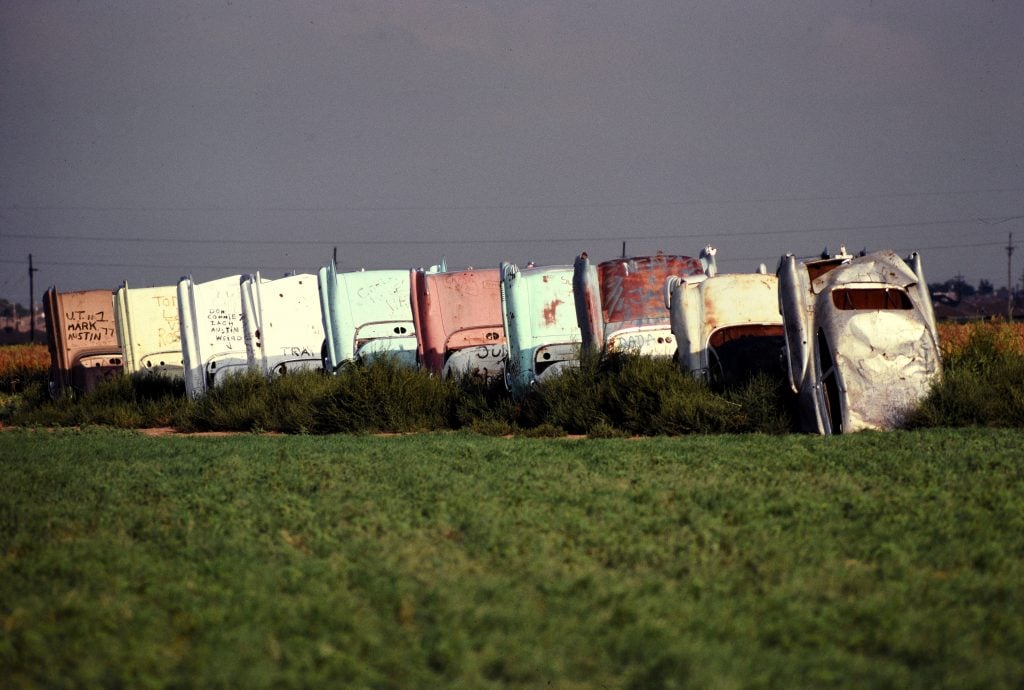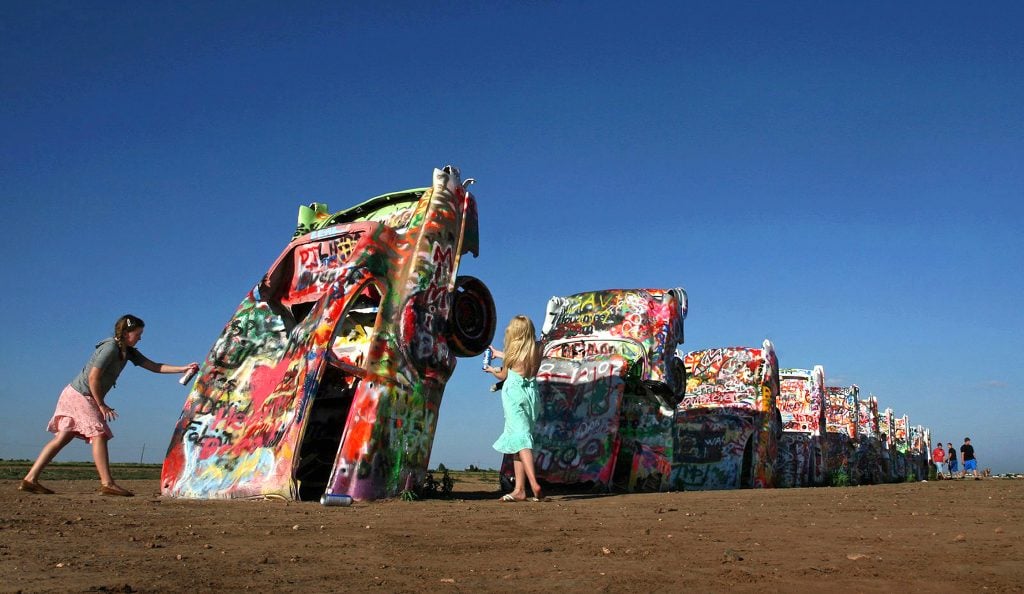Art History
Art Bites: Why an Art Collective Buried Cadillacs in the Texas Desert
The renown selfie spot is considered the Stonehenge of American car culture.

The renown selfie spot is considered the Stonehenge of American car culture.

Vittoria Benzine

Motorists traversing Interstate 40 near Amarillo, TX—the old Route 66—often gape at the sight of ten Cadillacs protruding tail-end out of the desert. The San Francisco-based architectural collective Ant Farm created this 50 year old installation, considered the Stonehenge of American car culture. Cadillac Ranch is a world-renowned selfie stop garnering 1.4 million visitors a year.
Ant Farm spent much of their ten year career criticizing the mass media that Cadillac Ranch now participates in. The work has fueled restaurant spin-offs, copycats, and merchandise—which Ant Farm profits off, since they own the copyright. An ode to Cadillac Ranch even appeared in Cars (2006). Steeped in the radical politics of the 1960s, though, founders Chip Lord and Doug Michels told the Journal of the Society of Architectural Historians, “We wanted to be an architecture group that was more like a rock band.”
MoMA owns the footage from Ant Farm’s incendiary stunt Media Burn (1975-2003), and their time capsules were featured at Pioneer Works in 2016. Cadillac Ranch, however, simply honors the rise and fall of the short-lived but iconic Cadillac tail fin. New Orleans-born artist Hudson Marquez joined Ant Farm soon after their founding. “We were car crazy,” he told Texas Highways. “It was always drawing cars, collaging cars, making art with cars. I had an idea to make seed packs where you could plant seeds that would grow cars.”
The collective landed in Amarillo after finishing House of the Century (1972) in Angleton, TX. Legend has it that they’d acquired a list of American millionaires who might be interested in funding their zany ideas. There, Ant Farm connected with eccentric Amarillo millionaire Stanley Marsh III, who asked them to draft a proposal for Cadillac Ranch. Their blueprint featured a simple budget for the backhoe and cars. After deliberation, Marsh offered funds and a wheat field to house the work.

Visitors spray painting Cadillac Ranch (Michael S. Williamson/The Washington Post via Getty Images)
Ant Farm spent six weeks at Toad Hall, Marsh’s estate. They placed ads in local papers seeking used Cadillacs, and spent their days bargain hunting for models of all ten Cadillacs featuring tail fins, from the 1963 Sedan de Ville to the 1949 Club Sedan—which proved their biggest challenge. According to Wyatt McSpadden, who was working at Toad Hall, “they finally found one on the east side of town over on the poor side of town, and a guy had restored it and was charging them way more money than they wanted.” When they got the title, Michels bashed the front end of the car to piss him off. It didn’t matter. That part was going in the ground.
Installation took less than a week, timed to the summer solstice. The cars’ slight tilt, mimicking the Pyramid of Giza, was apparently a lucky fluke. Ant Farm arranged the cars in a chronological line, facing west.
After a few years, Texans started shooting it. “It’s the Panhandle,” McSpadden remarked. “You got to shoot holes and stuff.” Then, the graffiti started. Sometimes the cars would get buffed all gray, or pink, or grey, but eventually those cleanup crews surrendered. In 1997, Cadillac Ranchˆmoved two miles west to accommodate Amarillo’s sprawl. The internet ignited the tourist rush soon after, and the graffiti intensified. Four years ago, Stanley Marsh IV installed a truck selling spray paint on the premises.
Today, the tail fins have all been destroyed, and here’s an active debate around whether Cadillac Ranch should be eventually restored. Although travelers would certainly miss the spectacle if it crumbled into the ground, Lord thinks it’s all part of the art.